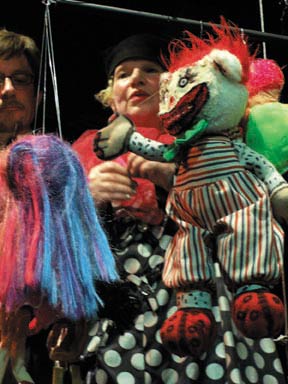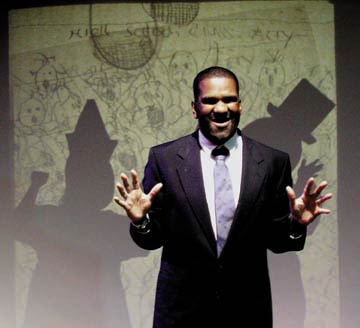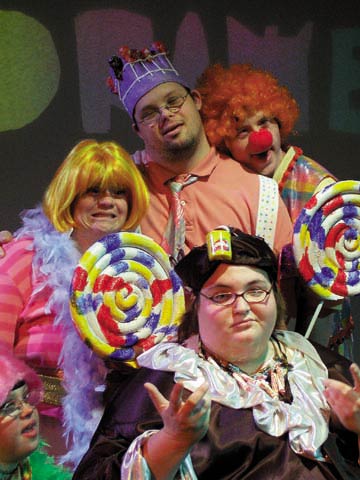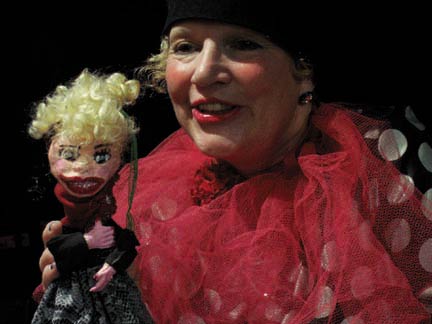Imagination and Memory: Interact Theater Company
The show, running through Dec. 18, is an extraordinary many-hearted creation. Dean Seal describes its unusual setting and contents.




I don’t know what anyone else thinks, because I don’t read the trades anymore. But I know what I think: Interact Theater does some of the best, most creative, form-stretching work of any company in town, bar none.
There’s plenty of innovation at some top-line showcase art houses, but a great deal of it is meaningless. There is a great deal of exquisite production at some top of the line theatrical institutions, but a great deal of it is formulaic, and none of it is surprising. A lot of high buck high art smells like the ancient ivory tower with this year’s room freshener spritzed about to make us think something is actually happening.
Enough about them, more about the Interactors.
The lobby sets the tone. It is decked out in art that is themed with the show, plus a shadow-puppet stage and a stick-puppet stage running before the show. There is a a “smelling bar” where you can sample a few bottled scents and then write down what it makes you think of. This gallery is newly remodeled, as is the performance space, and it makes for an attractive place to buy cool art while you are waiting for the show to begin. It sets the tone for the kind of wild and wooly production you are going to see: a naive approach that turns up unexpected gems of hard-won wisdom at every turn of the trail.
The show tells a half-dozen stories that each cut to the chase. This is a show about what happens to people who lose their memory and have to build a new one. Or people who have lost their sight, and find that it helps to focus their vision. Or someone who has one disability, envying people who have another. These are situations ripe for irony, but presented here as fact, not with anger, not with cynicism. Eriq Nelson narrates: ”…you have entered a place where you will not recognize things as they are, but as they are seen….remembered by the amnesiac through the lens of the eye of the imagination.”
Interact has been operating a split personality studio for a dozen years, with a fine arts studio and a performance company, and never the twain did meet, until now. This show marks the first experiment of moving artists between the two departments. “I don’t know why we didn’t do it before,” said Artistic Director Jeannie Calvit a few weeks before opening, “but it’s working great.” Studio artists were sent up stairs to work with the new show, and performers were encouraged to go downstairs to get some painting action.
But more than that. They hired a pair of famous artists, Ta-coumba Aiken and Lourdes Cue, to work on set design. They also brought in Michael Sommers to consult on a rear-screen projection system which allowed for shadow puppets, merging images and small tableaux silhouettes writ large.
The opening number features a ten-piece band (The Cigars of Beauty band) and a 22-voice chorus singing out a theme song, “There Is a Land of a Quiet God”. This is followed by the killer bit of the night, “Tracy’s Story.” Tracy tells the story of a seven-day seizure that rubbed out her memory. As she reconstructed what her life had been, it seemed like a memory worth erasing. She asked the poignant question, “Wasn’t there anyone in my life who loved me?” The answer was Yes. In one of her foster homes, there was a girl named Michelle, who bonded with her. They loved each other deeply, “fiercely” but could not be kept together because they were both disabled and the foster parents were getting old. By some luck, they managed to get placed on the same block, so they could maintain contact and even go to the same school. When Michelle was killed by a drunk driver, Tracy found out a story “which I cannot imagine or remember.” Michelle had actually been her sister, and the Catholic Charities, in one of their many silent miracles, had moved heaven and earth to keep the two together. They didn’t just care for these kids, they cared about them.
So now, Tracy could look at these pictures from an unremembered past, look into the eyes of her sister, and imagine being loved, and loving back. It’s enough to make a life out of.
Another story comes from Joy, who talks about the weird chromosomal problem called “Prater-Willi Syndrome.” She eats whatever she can get her hands on, and is cranky, and puts on weight. She envies the Down Syndrome people, who are always happy, and fun-loving, and cracking up.
John Boler has been a musician with the troupe for a long time, and he told about how he thinks that before he completely lost his sight at ten, he could perceive colors. Now he still can see them, in the blackness of his blindness, and even equates them with musical notes. He loves green, and was “disappointed to find out that chocolate wasn’t green.”
There are more stories than I have space for. But my point is that the form here is one of tailored delivery of substantial tales of people in mind-altering states of reality that fiction writers can only pretend to understand. They are presented with wit and strength, none of the feel-bad-for-me-the -tortured artist that one can encounter in other performance venues. This is a message of survival and hope delivered without cynicism, with honesty and without fraud, with clarity and without doing anything that needs to be explained. It’s real stuff, delivered transparently, by the storytellers who lived it.
As a staged-up storytelling cabaret, I think storytellers could learn a lot from this. Adding music, a singing chorus to tie the stories together through some musical knitting, lights and sounds and background visuals used effectively to put the story across make this a visual treat for a format that usually is better heard than seen. As a theater cabaret, it holds together because the stories keep connecting to the core theme. And it’s not a theme like the high school prom theme, something fake tacked together in a forced simile of meaning; it is a deep, true subject for anyone who walks in, or rolls in. It works for the disabled and the temporarily abled.
This is the real thing.
Showtimes:
Thursday 7:30 pm ($12)
Friday and Saturday 7:30 pm ($15)
Saturday Matinees at 3:00 pm ($12) )
Wednesday Matinee Noon December 15
includes brown bag lunch! ($12)
Tickets available through TICKETWORKS at 612-343-3390 or visit www.ticketworks.com